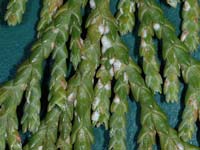PESTS AND DISEASES OF FORESTRY IN NEW ZEALAND
New insect found in Hamilton
Scion is the leading provider of forest-related knowledge in New Zealand
Formerly known as the Forest Research Institute, Scion has been a leader in research relating to forest health for over 50 years. The Rotorua-based Crown Research Institute continues to provide science that will protect all forests from damage caused by insect pests, pathogens and weeds. The information presented below arises from these research activities.
From Forest Health News 198, September 2009.
During the course of high risk surveys in Hamilton in May this year an armoured scale insect (Diaspididae) previously unknown from New Zealand was found infesting Juniperus chinensis. It is Carulaspis minima, a European species that is also established in North and South America, South Africa, Bermuda and Hawaii. Overseas it has been recorded from Callitris, Cedrus, Cephalotaxus, Chamaecyparis, Cryptomeria, Cupressus, Juniperus, Platycladus, Picea, Sequoia and Thuja. Juniperus appears to be the favoured host.

Heavy infestations can cause premature yellowing and dieback of green needles, branch dieback and even death of the host. In Europe in general it is considered to be a pest of ornamental plantings and in France is considered to be of economic importance. In Bermuda it is regarded a serious pest of Juniperus bermudiana as it can damage native forests and affects the tourist industry.
Worldwide there are about 7 species of Carulaspis. With one exception all known hosts are conifers. The exception is C. visci which is found on Viscum (mistletoe).
Another European species of Carulaspis, C. juniperi, is established in New Zealand. This species was recorded here in 1942 and has been recorded on a similar range of hosts as C. minima and is found throughout most of the country. Although C. visci is found on a completely different host it has been confused with both C. juniperi and C. minima. Carulaspis juniperi was first recorded in New Zealand as C. visci.
Thanks to Rosa Henderson (Landcare Research) for identifying Carulaspis minima.
John Bain
This information is intended for general interest only. It is not intended to be a substitute for specific specialist advice on any matter and should not be relied on for that purpose. Scion will not be liable for any direct, indirect, incidental, special, consequential or exemplary damages, loss of profits, or any other intangible losses that result from using the information provided on this site.
(Scion is the trading name of the New Zealand Forest Research Institute Limited.)

 Farm Forestry New Zealand
Farm Forestry New Zealand

